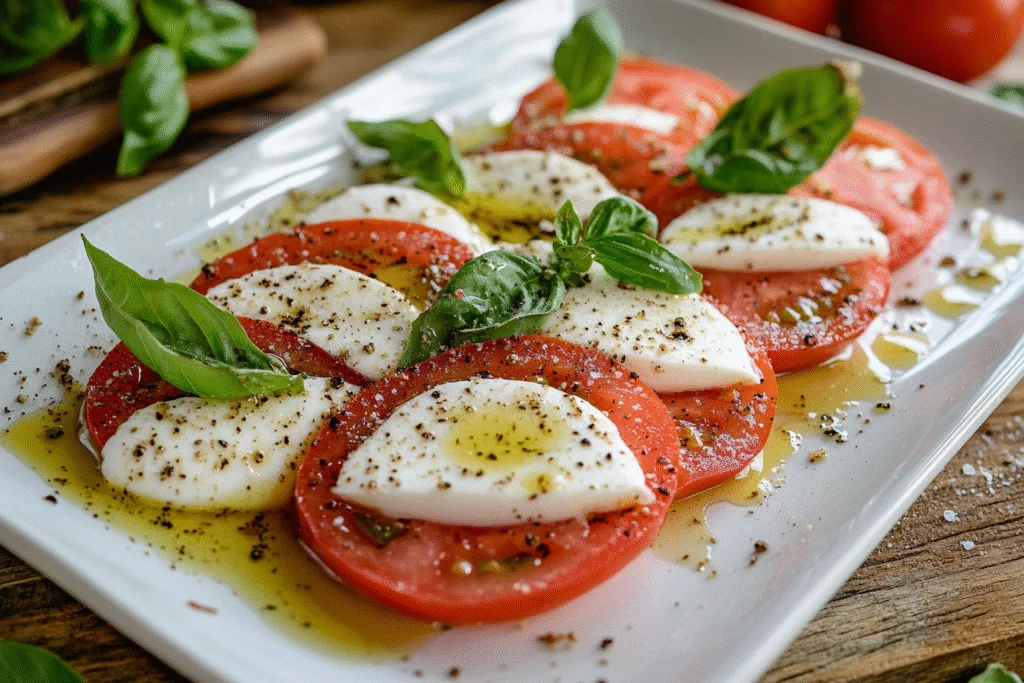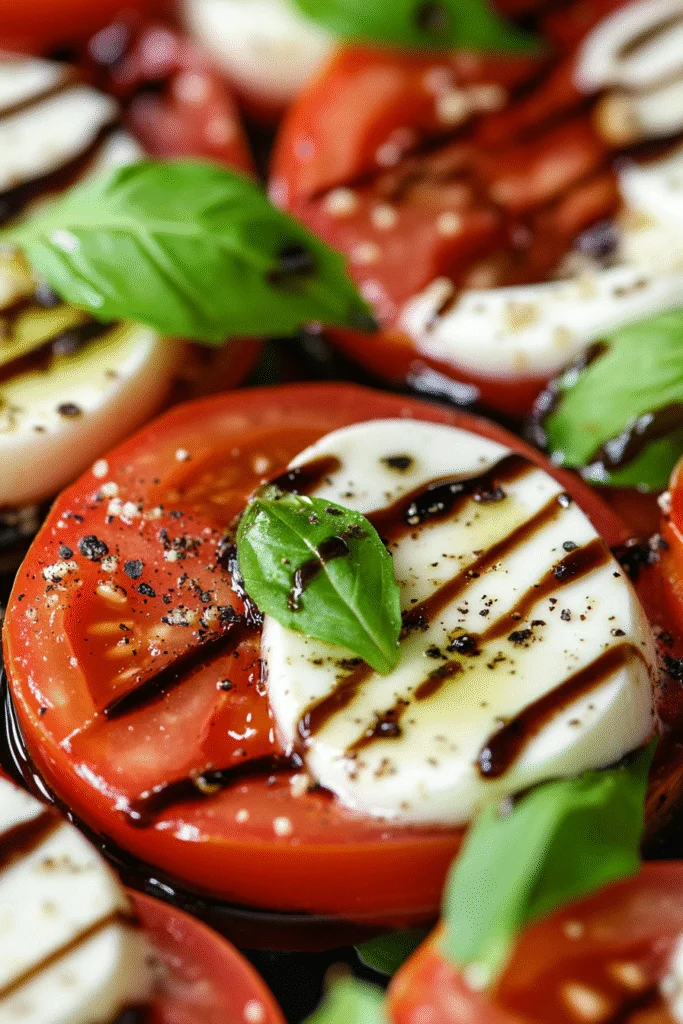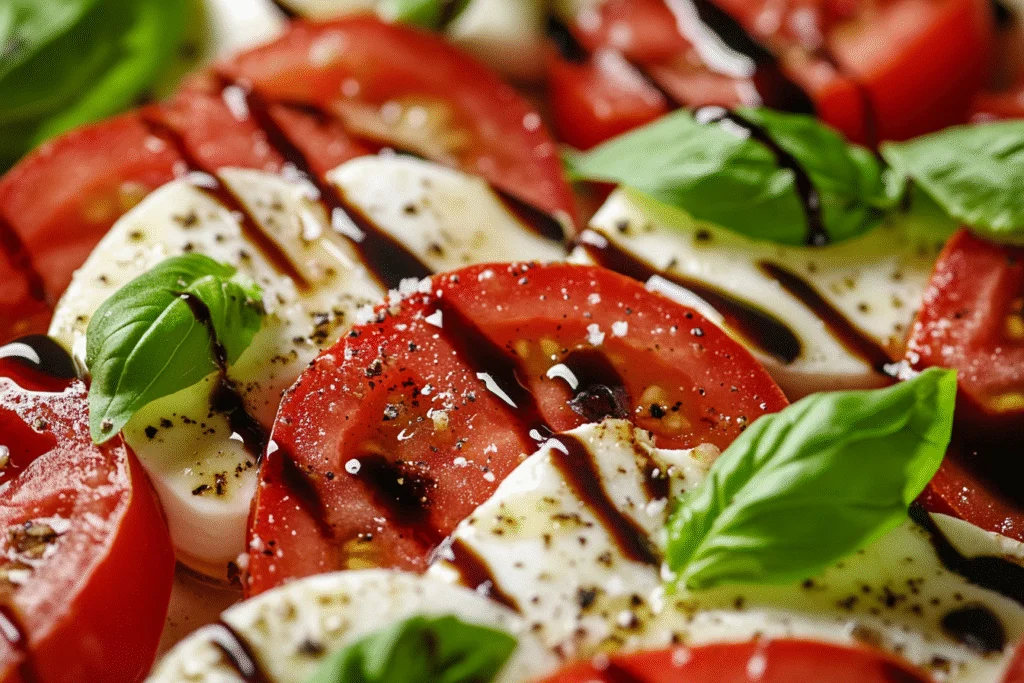Few dishes capture the essence of summer quite like a Caprese Salad. This Italian classic, known as Insalata Caprese, is a celebration of simplicity—a dish where each ingredient shines on its own while complementing the others perfectly. Made with fresh tomatoes, creamy mozzarella, fragrant basil, olive oil, and a touch of salt, Caprese Salad is the epitome of the “less is more” philosophy in cooking.
In this comprehensive guide, I’ll walk you through everything you need to create a flawless Caprese Salad, including how to select the best tomatoes and mozzarella, the importance of seasoning, preparation tips, troubleshooting common mistakes, and variations that let you get creative without compromising the dish’s integrity.
Why Caprese Salad Works: The Beauty of Simplicity
Caprese Salad is all about balance and quality. It consists of just a handful of ingredients, which means each one plays a crucial role in the final flavor and texture.
Core Elements:
- Ripe, Juicy Tomatoes: Sweet and tangy, they form the foundation.
- Fresh Mozzarella: Soft, creamy, and mildly flavored to complement the tomatoes.
- Fresh Basil: Adds aromatic brightness and herbal contrast.
- Extra Virgin Olive Oil: Provides richness and ties everything together.
- Salt and Pepper: Enhance natural flavors without overpowering.
When these ingredients are at their peak, the result is a refreshing, satisfying salad that feels both indulgent and light.

Selecting the Best Tomatoes: The Heart of the Dish
Tomatoes are the star of a Caprese Salad, so selecting the right ones is essential.
Best Tomato Varieties:
- Heirloom Tomatoes: Vibrant, juicy, and often uniquely sweet with stunning colors.
- Beefsteak Tomatoes: Meaty, less watery, and easy to slice.
- Vine-Ripened Tomatoes: Sweet and flavorful when in season.
- Cherry or Grape Tomatoes: Great for a bite-sized Caprese version.
Key Tips:
- Look for tomatoes that are firm but slightly yielding to the touch.
- They should smell sweet and tomatoey at the stem.
- Avoid tomatoes that feel too hard or have blemishes.
Choosing the Right Mozzarella
The mozzarella in Caprese Salad should be fresh, soft, and mild in flavor.
Best Options:
- Fresh Mozzarella Balls (Mozzarella di Bufala): Creamy, soft, and traditionally used.
- Bocconcini or Ciliegine: Small mozzarella balls, great for individual salads or skewers.
- Fior di Latte: A high-quality cow’s milk mozzarella with a slightly firmer texture.
Avoid:
- Pre-shredded or block mozzarella, which lacks the creamy texture needed for Caprese.
Serving Tip:
Let mozzarella come to room temperature before serving to maximize its flavor and creaminess.
The Importance of Seasoning and Oil
Caprese Salad relies on simple yet essential seasonings.
Salt:
- Flaky sea salt or kosher salt is best for enhancing the tomatoes and mozzarella without making them taste overly salty.
Pepper:
- Freshly cracked black pepper adds mild heat and aromatic complexity.
Olive Oil:
- Use high-quality extra virgin olive oil.
- Fruity, peppery oils work beautifully and add depth.
Optional Balsamic Glaze:
- Not traditional, but a drizzle of balsamic glaze can add a sweet-tangy dimension that many people enjoy.

Equipment Recommendations
Caprese Salad is refreshingly low-maintenance:
- Sharp chef’s knife: For clean, even tomato slices.
- Cutting board
- Serving platter or shallow dish
- Small spoon or squeeze bottle: If using balsamic glaze.
Optional: A serrated knife for very ripe tomatoes to prevent squashing.
Common Mistakes and How to Avoid Them
1. Using Unripe Tomatoes
- Unripe tomatoes are mealy and bland.
- Solution: Buy in-season tomatoes or let them ripen fully on the counter.
2. Cold Mozzarella
- Cold mozzarella is flavorless and firm.
- Solution: Bring mozzarella to room temperature for at least 20–30 minutes before serving.
3. Overcrowding the Platter
- When tomatoes and cheese are stacked too tightly, it becomes hard to serve and can look messy.
- Solution: Layer ingredients with slight overlap, leaving room for each slice to shine.
4. Using Low-Quality Olive Oil
- Cheap olive oil can leave a greasy aftertaste.
- Solution: Invest in a good bottle of extra virgin olive oil—it makes a noticeable difference.

Preparation Strategies and Meal Planning
Make-Ahead Tips:
- Slice the tomatoes and mozzarella ahead, but don’t assemble the salad until just before serving to prevent sogginess.
- Fresh basil can wilt quickly—add it at the last moment for maximum visual appeal.
Serving Temperature:
- Room temperature yields the best flavors for both the tomatoes and the cheese.
Presentation Tips:
- A round or oval platter works beautifully for fanned layers.
- Drizzle oil and glaze (if using) artistically for an elevated look.
Flavor Enhancements and Creative Variations
Traditional with a Twist:
- Add a sprinkle of crushed red pepper flakes for subtle heat.
- Use lemon zest for brightness.
- Incorporate fresh oregano or thyme alongside basil.
Protein Additions:
- Add thinly sliced prosciutto for a salty, savory touch.
- Top with grilled chicken for a light lunch version.
Fun Serving Ideas:
- Caprese Skewers: Thread mozzarella balls, basil leaves, and cherry tomatoes onto small skewers.
- Caprese Toast: Layer ingredients on grilled baguette slices.
- Caprese Pasta Salad: Toss with cooked pasta, olive oil, and fresh herbs.
Ingredient List
For the Salad:
- 4 large ripe tomatoes (heirloom, beefsteak, or vine-ripened)
- 12 ounces (340 g) fresh mozzarella, sliced
- 1 bunch fresh basil leaves
- 2 tablespoons extra virgin olive oil
- Flaky sea salt or kosher salt, to taste
- Freshly ground black pepper, to taste
Optional:
- 1–2 tablespoons balsamic glaze for drizzling
Step-By-Step Instructions
1. Prepare the Tomatoes and Mozzarella
Slice tomatoes into ¼-inch thick rounds.
Slice fresh mozzarella into similarly sized rounds.
Allow both to come to room temperature for about 20–30 minutes for optimal flavor.
2. Assemble the Salad
On a large serving platter, alternate tomato and mozzarella slices in a slightly overlapping pattern.
Tuck fresh basil leaves between each layer.
3. Season the Salad
Sprinkle with flaky sea salt and freshly ground black pepper to taste.
4. Drizzle with Olive Oil
Generously drizzle extra virgin olive oil over the entire salad.
If using, lightly drizzle balsamic glaze over the top in a decorative pattern.
5. Serve
Serve immediately at room temperature.
Caprese Salad is best enjoyed fresh, ideally within an hour of assembling to preserve the texture and brightness of the ingredients.
Troubleshooting and FAQs
Can I use cherry tomatoes instead?
Yes! Slice them in half and layer with small mozzarella balls (bocconcini or ciliegine) for a more casual, bite-sized presentation.
What if I can’t find fresh mozzarella?
If unavailable, burrata is a luxurious alternative. Avoid using processed block mozzarella or shredded varieties.
Can I use dried basil?
No. Dried basil won’t provide the necessary freshness or texture. Fresh basil is essential.
Can I make this salad in advance?
You can slice tomatoes and mozzarella a few hours ahead and refrigerate separately, but it’s best to assemble and season just before serving to keep everything crisp and vibrant.
Variations: Classic, Skewered, and Modern Takes
| Style | Tomato Type | Mozzarella | Presentation |
|---|---|---|---|
| Classic | Heirloom or beefsteak | Fresh sliced mozzarella | Layered on a platter |
| Skewers | Cherry tomatoes | Bocconcini or ciliegine | Threaded on toothpicks |
| Modern | Mixed heirloom, grape tomatoes | Burrata | Deconstructed with torn mozzarella |
Each variation offers unique textures and is ideal for different occasions—from elegant dinners to casual picnics.
Storage and Serving Tips
- Storage: Caprese Salad is best enjoyed fresh. If needed, leftovers can be stored for 1 day but may become watery.
- Serving Temperature: Always serve at room temperature for maximum flavor.
- Transporting: If bringing to a gathering, assemble on-site or transport tomatoes and mozzarella separately to prevent sogginess.
Final Thoughts
Easy Caprese Salad is proof that sometimes the simplest recipes are the most satisfying. When you use the freshest, highest-quality ingredients, this dish practically assembles itself, requiring minimal effort but offering maximum payoff in flavor and presentation.
Perfect as a starter, a light lunch, or a beautiful addition to a summer spread, Caprese Salad is versatile, elegant, and timeless. Whether you enjoy it in its purest form or add a creative twist, it’s sure to become a regular in your kitchen rotation.
Let me know how you make yours—whether you keep it classic, try the skewer version, or explore new flavor pairings!
